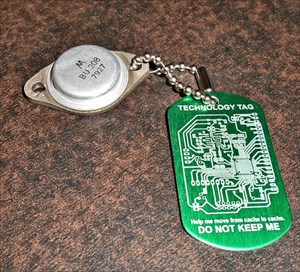| Trackable Options |
 Found this item? Log in.
Found this item? Log in. |
 Printable information sheet to attach to BU208
Print Info Sheet
Printable information sheet to attach to BU208
Print Info Sheet |
| There are 2 users watching this listing. |
This is not collectible.

About the BU208:
The item attached to this technology tag is a BU208, high voltage power transistor, manufactured by the multiepitaxial mesa process, designed for fast switching horizontal deflection circuits in color televisions in the 1970's.
With his 1884 patent of the Nipkow disc, German technician Paul Nipkow is regarded as the inventor of the TV set. Nipkow was a German born on 22 August 1860 in Lauenburg (Lębork) in Pomerania, now in Poland
This TB would like to travel to the birthplace of Paul Gottlieb Nipkow, inventor of the TV Set.
Paul Gottlieb Nipkow Biography (1860-1940):

Nipkow, now considered the forefather of the television age, received littlerecognition for his contribution during his lifetime. Italian physicist Guglielmo Marconi demonstrated a device that could transmit an audio signal in thelate 1890s. Nipkow was born on August 22, 1860, in Lauenburg, now Lębork in Poland. Inspired by the work of Marconi, Nipkow began thinking about the challenge of transmitting a visual image while still a student in Germany. It was well known that any successful transmission device required three essential components: adevice to translate the visual image into an electronic impulse, a second device to reassemble that impulse into an image, and a third device by which totransmit the impulse from the first device to the second. In 1884, even before completing his degree, Nipkow had developed and patented a transmissions system that achieved all three requirements.
Nipkow's television was based upon an ingenious device called a Nipkow disk, which was a metal or cardboard disk that was perforated with twenty square holes arranged in a spiral so that each hole was a little closer to thecenter than the last. As Nipkow spun the disk, he shined a strong light through the holes and onto the subject. Because each hole was slightly offset, theimage was scanned in a series of twenty horizontal lines.
In order to translate these lines into an electrical signal, Nipkow employeda selenium photoelectric cell (a device with which he had previously worked with extensively). The cell recorded the light and dark areas within each of the twenty scanned lines, converting these into a transmittable signal. In order to view the signal, Nipkow essentially reversed the process. He used a light source that flashed brightly or dimly according to the incoming signal. Tothis he added a second scanning disk, placed in front of the flashing lightand synchronized with the first disk, so that the light shone through the holes and projected twenty scanned lines onto a screen.
The main drawback to Nipkow's invention was not its design but its timing: the concept of television was so advanced that no producer or investor could envision a practical use for it. Though Nipkow used his device to transmit a visual image via telegraph wire from London to Paris, his mechanical televisionnever quite caught on. Nipkow himself eventually abandoned electronics and spent the rest of his life as a railway engineer. He died in Berlin, Germany,on August 24, 1940.
It was not until 1929 that another scientist, the Scottish engineer John Logie Baird, made certain improvements upon the Nipkow design and reintroduced itto the world. While Baird's design was still essentially mechanical, it cameat a time when the world was ready to embrace the concept of television. Photomechanical televisions were soon replaced by completely electronic devices,but even today's models rely upon the horizontal-scanning method first conceived of by Nipkow.
Read more: http://www.madehow.com/inventorbios/71/Paul-Gottlieb-Nipkow.html#ixzz34EQBFaVr
|
dlx12 retrieved it from Sentier de promenade Spirou 6
|
Namur, Belgium
|
Visit Log
|
Voilà transistor récupèré il va poursuivre sa route après une longue pause (problème santé) .. Dlx12 et Maëna
|
|
thiran posted a note for it
|
|
Visit Log
|
TB non présent dans la cache
|
|
dlx12 posted a note for it
|
|
Visit Log
|
Objet récupéré, merci pour l'échange, il va continuer son chemin, je donnerai suite.. c est le premier du genre pour nous. Le temps de se renseigner et il poursuivra sa route... Maëna, Emy Dlx12
|
|
LstephyL placed it in Sentier de promenade Spirou 6
|
Namur, Belgium
- 9.52 miles
|
Visit Log
|
|
|
|
MisterT. discovered it
|
|
Visit Log
|
Discovered it. Thank you for sharing.
|
|
Lucky'7 discovered it
|
|
Visit Log
|
Discovered it. Thank you for sharing.
|
|
LstephyL retrieved it from Welcome at the Bug House- TB HOTEL
|
Namur, Belgium
|
Visit Log
|
|
|
|
dagarjaira discovered it
|
Namur, Belgium
|
Visit Log
|
Vu sur une photo d'une cache d'un potentiel futur parcours. Merci pour le partage
|
|
Theodd1 discovered it
|
Namur, Belgium
|
Visit Log
|
Discovered in the TB/GC Gallery
Thank you very much for sharing.
|
|
CCCL68 discovered it
|
Namur, Belgium
|
Visit Log
|
Discovered in the TB/GC Gallery
Thank you very much for sharing.
Discover: ZEZ2DP and more
|
|
data on this page is cached for 3 mins
|